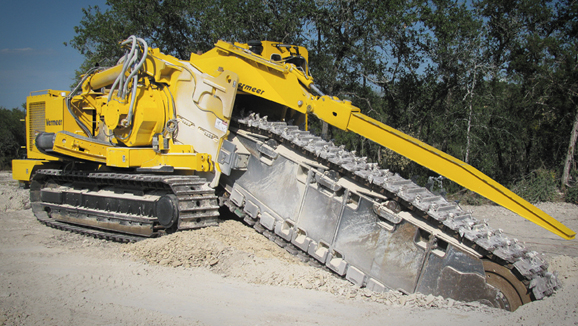Trenching equipment
Contents |
[edit] Introduction
A trench is an excavation the length of which greatly exceeds the depth. Shallow trenches are usually considered to be less than 6m deep and deep trenches greater than 6 m. Depending on the dimensions of a trench, excavation can be carried out by hand or by a mechanical digger.
There is a wide range of equipment that can be used for excavating trenches.
[edit] Hand trenching tools
Spades or digging shovels can be used for the first foot of trench depth, but for deeper trenches, special hand trenching tools and shovels are more appropriate. These allow the user to stand straighter and remain at ground level.
[edit] Trenching shovel
This type of shovel is usually employed after a powered trencher and is designed to clear loose material from the bottom of a narrow trench. The narrow width of trenching shovels means they are not suitable for digging.
[edit] Trenching hoe
Also known as a grub hoe, this is used standing at ground level, chopping soil loose and dragging it up the ramped end of a trench.
[edit] Trenchers
Trenchers are pieces of mechanical equipment used to excavate and prepare trenches. Different kinds of trencher can be used depending on the width and depth required and the nature of the material to be cut.
[edit] Wheel trencher
Also known as rockwheels, wheel trenchers are fitted with a toothed metal wheel and can be used in hard or soft soils. They can also be used for cutting pavements and for creating access to utilities under roads. They can be mounted on tracks or rubber tyres.
Depending on diameter, there are 6-8 cutting elements placed around the wheel which bear high-strength steel teeth, arranged in a semi-spherical configuration to increase material removal. The design of the wheel enables cutting of varying depths, and a constant soil working angle with a relatively small wheel diameter.
[edit] Chain trencher
This is a chainsaw-like trencher which uses a digging chain or belt to cut the ground. The belt is driven around a rounded metal frame or boom, the angle of which can be adjusted to control the cut depth. The boom is held at a fixed angle while the machine slowly moves.
Chain trenchers are used to cut hard ground, and are flexible enough to be able to cut narrow, deep and wider trenches for utilities. A conveyor belt on either side of the trencher removes the excavated materials.
[edit] Skimmer
Also known trenching machines, skimmers are used for excavating long trenches, such as those necessary for pipelines. They will normally dig trenches 0.25-1.5 m wide and up to 3 m deep, where a high degree of accuracy is required. The machine moves forwards, excavating with buckets either mounted on a wheel at the front, or on a chain which is carried by a jib.
[edit] Micro trencher
Micro trenchers are used for excavating narrow trenches, usually in urban areas. Widths range from 30-130 mm (1.2-5.1 in), with depths of 500 mm (20 in) or less.
The reduced trench size means that there is a reduction in the volume of excavated waste material, and disturbance can be minimised. They are sometimes radio-controlled and are used for road maintenance and to gain access to utilities under the road surface.
[edit] Portable trencher
Portable trenchers are lightweight and easy to handle, and can used to instal landscape edging and irrigation lines. They use a chain or a blade, similar to a rotary lawnmower, rotating in a vertical plane.
[edit] Tractor mount trencher
Tractor mount trenchers are a type of chain trencher, pulled by a creeping gear tractor which must be able to go as slowly as the trencher’s trenching speed.
[edit] Find out more
[edit] Related articles on Designing Buildings Wiki
Featured articles and news
One of the most impressive Victorian architects. Book review.
RTPI leader to become new CIOB Chief Executive Officer
Dr Victoria Hills MRTPI, FICE to take over after Caroline Gumble’s departure.
Social and affordable housing, a long term plan for delivery
The “Delivering a Decade of Renewal for Social and Affordable Housing” strategy sets out future path.
A change to adoptive architecture
Effects of global weather warming on architectural detailing, material choice and human interaction.
The proposed publicly owned and backed subsidiary of Homes England, to facilitate new homes.
How big is the problem and what can we do to mitigate the effects?
Overheating guidance and tools for building designers
A number of cool guides to help with the heat.
The UK's Modern Industrial Strategy: A 10 year plan
Previous consultation criticism, current key elements and general support with some persisting reservations.
Building Safety Regulator reforms
New roles, new staff and a new fast track service pave the way for a single construction regulator.
Architectural Technologist CPDs and Communications
CIAT CPD… and how you can do it!
Cooling centres and cool spaces
Managing extreme heat in cities by directing the public to places for heat stress relief and water sources.
Winter gardens: A brief history and warm variations
Extending the season with glass in different forms and terms.
Restoring Great Yarmouth's Winter Gardens
Transforming one of the least sustainable constructions imaginable.
Construction Skills Mission Board launch sector drive
Newly formed government and industry collaboration set strategy for recruiting an additional 100,000 construction workers a year.
New Architects Code comes into effect in September 2025
ARB Architects Code of Conduct and Practice available with ongoing consultation regarding guidance.
Welsh Skills Body (Medr) launches ambitious plan
The new skills body brings together funding and regulation of tertiary education and research for the devolved nation.
Paul Gandy FCIOB announced as next CIOB President
Former Tilbury Douglas CEO takes helm.























